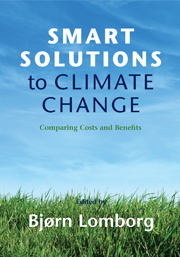Book contents
- Frontmatter
- Contents
- List of figures
- List of tables
- List of contributors
- Acknowledgments
- List of abbreviations and acronyms
- Introduction
- PART I THE SOLUTIONS
- 1 Climate Engineering
- 2 Carbon Dioxide Mitigation
- 3 Forestry Carbon Sequestration
- 4 Black Carbon Mitigation
- 5 Methane Mitigation
- 6 Market- and Policy-Driven Adaptation
- 7 Technology-Led Climate Policy
- 8 Technology Transfer
- PART II RANKING THE OPPORTUNITIES
- Conclusion
- Index
- References
4 - Black Carbon Mitigation
Published online by Cambridge University Press: 05 June 2012
- Frontmatter
- Contents
- List of figures
- List of tables
- List of contributors
- Acknowledgments
- List of abbreviations and acronyms
- Introduction
- PART I THE SOLUTIONS
- 1 Climate Engineering
- 2 Carbon Dioxide Mitigation
- 3 Forestry Carbon Sequestration
- 4 Black Carbon Mitigation
- 5 Methane Mitigation
- 6 Market- and Policy-Driven Adaptation
- 7 Technology-Led Climate Policy
- 8 Technology Transfer
- PART II RANKING THE OPPORTUNITIES
- Conclusion
- Index
- References
Summary
Introduction
Much attention has been given to mitigation policies designed to limit the emissions of carbon dioxide (CO2) and other greenhouse gases (GHGs) that contribute to atmospheric warming. However, it is generally agreed that as much as 40% of current net warming (10–20% of gross warming) is attributable to black carbon (Jacobsen 2007: 3). Because of its large effect on radiative forcing and relatively short residence time in the atmosphere, black carbon presents some unique opportunities for postponing the effects of climate change. Whereas CO2 has a lifetime of up to about forty years, black carbon remains in the atmosphere for as little as several weeks. As such, reducing emissions of black carbon can have an immediate near-term impact on atmospheric warming. Furthermore, since black carbon is considered responsible for about 30% of the Arctic melting, black carbon emission reductions can rapidly reduce the rate at which Arctic ice is melting and avert associated consequences. Black carbon reduction policies can also result in large health benefits, especially to citizens of developing countries.
Black carbon emissions originate in both industrial countries (mostly from diesel emissions) and developing countries (from residential activities, crop management, and diesel emissions). Over the past century, technological advances have significantly mitigated black carbon emissions in industrial countries. Developing countries, on the other hand, have often been unable to afford the same technological advances and, in turn, as their populations have grown, so have black carbon emissions.
- Type
- Chapter
- Information
- Smart Solutions to Climate ChangeComparing Costs and Benefits, pp. 142 - 171Publisher: Cambridge University PressPrint publication year: 2010
References
- 7
- Cited by



